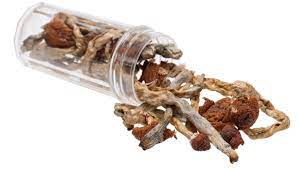Uncategorized
The Complete Guide to Growing Golden Teacher Mushrooms: Timeframes and Tips for Success
Golden Teacher mushrooms, a popular strain of Psilocybe cubensis, are renowned for their striking appearance and potent effects. Cultivating these mushrooms can be a rewarding venture, but it’s essential to understand the timeframes involved in the growing process to ensure a successful harvest. This comprehensive guide will cover the entire cultivation journey of Golden Teacher mushrooms, detailing how long it takes to grow them, key factors influencing growth, and tips for optimizing your mushroom-growing experience.

1. Introduction to Golden Teacher Mushrooms
Golden Teacher mushrooms are one of the most sought-after strains of Psilocybe cubensis, a species of psychedelic mushrooms. They are celebrated for their golden-hued caps, spiritual effects, and relatively easy cultivation compared to other psychedelic strains.
Characteristics of Golden Teacher Mushrooms:
- Cap Color: Golden to yellowish-brown, often with a slightly reddish tint.
- Cap Shape: Starts convex and flattens out with age, sometimes developing wavy edges.
- Size: Medium to large, with caps that can reach up to 5 cm (2 inches) in diameter.
- Spore Print: Purplish-brown, indicating maturity.
Cultivation Overview: Golden Teachers are known for their resilience and ability to adapt to various growing conditions. Understanding the timeline for each stage of growth is crucial for achieving optimal results.
2. The Growth Cycle of Golden Teacher Mushrooms
Growing Golden Teacher mushrooms involves several stages, each with its own timeframe. Here’s a detailed look at each phase of the cultivation process:
1. Preparation and Inoculation
- Substrate Preparation: Prepare your growing substrate, which typically consists of brown rice flour, vermiculite, and water. Sterilize the mixture using a pressure cooker or autoclave. This process usually takes about 1-2 hours.
- Inoculation: Once the substrate is cooled, inoculate it with Golden Teacher spore solution. This involves injecting spores into the substrate and is done in a sterile environment. The inoculation process itself is quick, usually taking less than an hour.

2. Colonization
- Initial Growth: After inoculation, the jars or containers are placed in a warm, dark place (around 75°F or 24°C) for colonization. This phase typically lasts 2-4 weeks. During this period, you’ll observe white, fuzzy mycelium spreading throughout the substrate.
- Monitoring: Regularly check for signs of contamination, such as unusual colors or smells. Healthy mycelium growth should be white and uniform.
3. Fruiting
- Preparing for Fruiting: Once the substrate is fully colonized, transfer it to a fruiting chamber. This chamber should have high humidity, fresh air exchange, and light. This setup can be a simple plastic bin with perlite or a more elaborate humidity tent.
- Initiation: Expose the colonized substrate to light and slightly lower temperatures (65-75°F or 18-24°C). This signals the mycelium to start producing mushrooms. Fruiting typically begins 1-2 weeks after transferring to the fruiting chamber.
4. Harvesting
- Mushroom Development: Golden Teacher mushrooms will start to appear as small pins and gradually grow into mature mushrooms. Harvesting should be done when the caps are fully expanded and the veil beneath them begins to break. This stage usually occurs 1-2 weeks after fruiting begins.
- Post-Harvest: After harvesting, mushrooms need to be dried to prevent mold. Drying time can vary but generally takes 1-2 days.
3. Factors Influencing Growth Time
Several factors can affect the time it takes to grow Golden Teacher mushrooms. Here’s a breakdown of these factors and how they influence the growth timeline:
1. Temperature
- Colonization: The ideal temperature for colonization is around 75°F (24°C). Cooler temperatures can slow down mycelial growth, while higher temperatures can increase the risk of contamination.
- Fruiting: Lower temperatures (65-75°F or 18-24°C) are recommended during fruiting. Temperature fluctuations can impact the speed and quality of mushroom development.
2. Humidity
- Colonization: High humidity is less critical during colonization but is essential during fruiting. Maintain humidity levels around 85-95% in the fruiting chamber to encourage healthy mushroom growth.
- Fruiting: Consistent humidity helps prevent the mushrooms from drying out and supports proper development.
3. Light
- Fruiting Initiation: Light plays a crucial role in signaling the mycelium to start fruiting. Provide indirect light for 12 hours a day to mimic natural conditions.
- Intensity: While bright light is not necessary, a consistent light source is important for promoting even growth and preventing stunted development.
4. Sterilization and Contamination
- Sterilization: Proper sterilization of substrates and equipment is essential to prevent contamination. Contaminants can slow growth and negatively affect the overall yield.
- Contamination Control: Regularly check for signs of mold or bacterial contamination and address any issues promptly.
5. Substrate Quality
- Nutrient Content: A well-balanced substrate provides the necessary nutrients for mycelial growth and mushroom development. Quality substrates can lead to faster and more robust growth.
- Moisture Levels: Ensure the substrate is properly hydrated but not overly wet. Excess moisture can lead to contamination and slower growth.
4. Tips for Optimal Growth and Efficiency
To ensure a successful and efficient growing process for Golden Teacher mushrooms, consider these expert tips:
1. Maintain Sterility
- Clean Environment: Work in a clean, sterile environment to minimize contamination risks. Use sanitized tools and equipment.
- Proper Handling: Avoid touching the substrate or mushrooms with bare hands. Use gloves and sterilized tools to handle materials.
2. Monitor Conditions Regularly
- Temperature and Humidity: Regularly check and adjust the temperature and humidity levels in your fruiting chamber to maintain optimal conditions.
- Visual Inspections: Keep an eye on the growth progress and look for any signs of contamination or abnormal growth.
3. Document Your Process
- Record Keeping: Maintain a detailed log of your cultivation process, including temperatures, humidity levels, and any observations. This will help you identify patterns and make improvements for future grows.
4. Educate Yourself
- Research: Stay informed about best practices and any new developments in mushroom cultivation. Joining online forums or local cultivation groups can provide valuable insights and support.
5. Be Patient
- Growth Time: Understanding that mushroom cultivation is a gradual process can help manage expectations. Patience is key to achieving a successful harvest.
5. Comparing Golden Teacher Mushrooms with Other Strains
While Golden Teacher mushrooms are a popular choice, other strains of Psilocybe cubensis offer different characteristics and growth times. Here’s a brief comparison:
1. Amazonian Shrooms
- Appearance: Darker caps with larger sizes compared to Golden Teachers.
- Potency: Often reported to be more potent, with stronger visual and cognitive effects.
- Growth Time: Similar growth times to Golden Teachers, but may require more precise conditions.
2. B+ Strain
- Appearance: Larger caps and more robust growth compared to Golden Teachers.
- Potency: Moderate potency with balanced effects.
- Growth Time: Generally has a similar cultivation timeframe but can sometimes produce larger yields.
3. Cambodia Strain
- Appearance: Smaller and more delicate mushrooms with a lighter cap color.
- Potency: Known for potent effects with a more energetic trip.
- Growth Time: Comparable growth time to Golden Teachers, though some find it grows slightly faster.

6. Conclusion
Growing Golden Teacher mushrooms can be a rewarding experience, providing both a fascinating cultivation process and a potent final product. By understanding the timeframes for each stage of growth and paying attention to factors like temperature, humidity, and sterility, you can optimize your cultivation efforts and achieve a successful harvest.
Whether you’re a novice cultivator or an experienced grower, this guide offers a detailed roadmap to growing Golden Teacher mushrooms. With patience, care, and attention to detail, you can enjoy the process of cultivating these remarkable fungi and appreciate the unique qualities they bring.
Happy cultivating and harvesting!
This in-depth guide covers the entire process of growing Golden Teacher mushrooms, from understanding their growth cycle to optimizing conditions for the best results. By following these guidelines, you’ll be well-equipped to successfully cultivate these popular psychedelic mushrooms.
